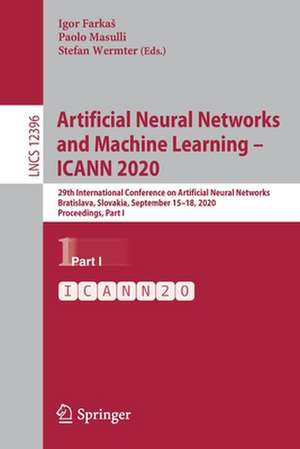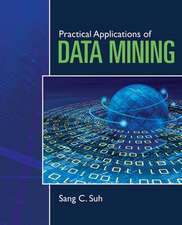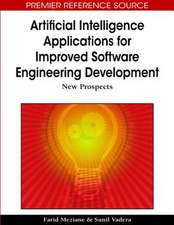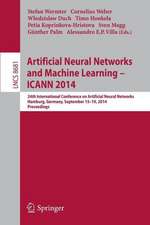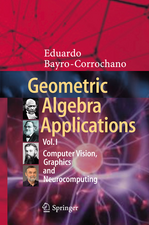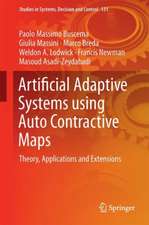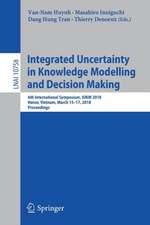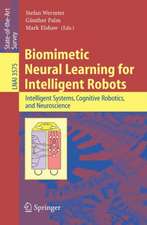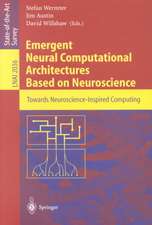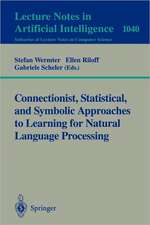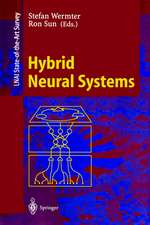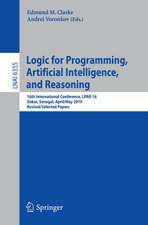Artificial Neural Networks and Machine Learning – ICANN 2020: 29th International Conference on Artificial Neural Networks, Bratislava, Slovakia, September 15–18, 2020, Proceedings, Part I: Lecture Notes in Computer Science, cartea 12396
Editat de Igor Farkaš, Paolo Masulli, Stefan Wermteren Limba Engleză Paperback – 20 oct 2020
*The conference was postponed to 2021 due to the COVID-19 pandemic.
| Toate formatele și edițiile | Preț | Express |
|---|---|---|
| Paperback (2) | 676.16 lei 6-8 săpt. | |
| Springer International Publishing – 20 oct 2020 | 676.16 lei 6-8 săpt. | |
| Springer International Publishing – 17 oct 2020 | 676.16 lei 6-8 săpt. |
Din seria Lecture Notes in Computer Science
- 20%
 Preț: 1061.55 lei
Preț: 1061.55 lei - 20%
 Preț: 307.71 lei
Preț: 307.71 lei - 20%
 Preț: 438.69 lei
Preț: 438.69 lei - 20%
 Preț: 579.30 lei
Preț: 579.30 lei -
 Preț: 410.88 lei
Preț: 410.88 lei - 17%
 Preț: 427.22 lei
Preț: 427.22 lei - 20%
 Preț: 596.46 lei
Preț: 596.46 lei - 15%
 Preț: 448.04 lei
Preț: 448.04 lei - 20%
 Preț: 353.50 lei
Preț: 353.50 lei -
 Preț: 389.49 lei
Preț: 389.49 lei - 20%
 Preț: 309.90 lei
Preț: 309.90 lei - 20%
 Preț: 645.28 lei
Preț: 645.28 lei - 20%
 Preț: 763.23 lei
Preț: 763.23 lei - 15%
 Preț: 580.46 lei
Preț: 580.46 lei - 20%
 Preț: 310.28 lei
Preț: 310.28 lei - 20%
 Preț: 655.02 lei
Preț: 655.02 lei - 20%
 Preț: 1183.14 lei
Preț: 1183.14 lei - 20%
 Preț: 340.32 lei
Preț: 340.32 lei -
 Preț: 449.57 lei
Preț: 449.57 lei - 20%
 Preț: 591.51 lei
Preț: 591.51 lei - 18%
 Preț: 938.83 lei
Preț: 938.83 lei - 20%
 Preț: 337.00 lei
Preț: 337.00 lei - 20%
 Preț: 649.50 lei
Preț: 649.50 lei - 20%
 Preț: 607.40 lei
Preț: 607.40 lei - 20%
 Preț: 1414.79 lei
Preț: 1414.79 lei - 20%
 Preț: 1024.44 lei
Preț: 1024.44 lei - 20%
 Preț: 583.40 lei
Preț: 583.40 lei - 20%
 Preț: 453.32 lei
Preț: 453.32 lei - 20%
 Preț: 575.49 lei
Preț: 575.49 lei - 20%
 Preț: 1075.26 lei
Preț: 1075.26 lei - 20%
 Preț: 585.88 lei
Preț: 585.88 lei - 20%
 Preț: 825.93 lei
Preț: 825.93 lei - 17%
 Preț: 360.20 lei
Preț: 360.20 lei - 20%
 Preț: 763.23 lei
Preț: 763.23 lei - 20%
 Preț: 340.32 lei
Preț: 340.32 lei - 20%
 Preț: 504.58 lei
Preț: 504.58 lei - 20%
 Preț: 369.13 lei
Preț: 369.13 lei - 20%
 Preț: 580.93 lei
Preț: 580.93 lei - 20%
 Preț: 343.62 lei
Preț: 343.62 lei - 20%
 Preț: 350.21 lei
Preț: 350.21 lei - 20%
 Preț: 583.40 lei
Preț: 583.40 lei - 20%
 Preț: 583.40 lei
Preț: 583.40 lei - 15%
 Preț: 438.59 lei
Preț: 438.59 lei - 20%
 Preț: 341.95 lei
Preț: 341.95 lei - 20%
 Preț: 238.01 lei
Preț: 238.01 lei - 20%
 Preț: 538.30 lei
Preț: 538.30 lei
Preț: 676.16 lei
Preț vechi: 845.20 lei
-20% Nou
Puncte Express: 1014
Preț estimativ în valută:
129.38€ • 135.10$ • 106.84£
129.38€ • 135.10$ • 106.84£
Carte tipărită la comandă
Livrare economică 15-29 aprilie
Preluare comenzi: 021 569.72.76
Specificații
ISBN-13: 9783030616083
ISBN-10: 3030616088
Pagini: 4000
Ilustrații: XXVII, 891 p. 348 illus., 260 illus. in color.
Dimensiuni: 155 x 235 mm
Greutate: 1.26 kg
Ediția:1st ed. 2020
Editura: Springer International Publishing
Colecția Springer
Seriile Lecture Notes in Computer Science, Theoretical Computer Science and General Issues
Locul publicării:Cham, Switzerland
ISBN-10: 3030616088
Pagini: 4000
Ilustrații: XXVII, 891 p. 348 illus., 260 illus. in color.
Dimensiuni: 155 x 235 mm
Greutate: 1.26 kg
Ediția:1st ed. 2020
Editura: Springer International Publishing
Colecția Springer
Seriile Lecture Notes in Computer Science, Theoretical Computer Science and General Issues
Locul publicării:Cham, Switzerland
Cuprins
Adversarial Machine Learning.- On the security relevance of initial weights in deep neural networks.- Fractal Residual Network for Face Image Super-Resolution.- From Imbalanced Classification to Supervised Outlier Detection Problems: Adversarially Trained Auto Encoders.- Generating Adversarial Texts for Recurrent Neural Networks.- Enforcing Linearity in DNN succours Robustness and Adversarial Image Generation.- Computational Analysis of Robustness in Neural Network Classifiers.- Bioinformatics and Biosignal Analysis.- Convolutional neural networks with reusable full-dimension-long layers for feature selection and classification of motor imagery in EEG signals.- Compressing Genomic Sequences by Using Deep Learning.- Learning Tn5 sequence bias from ATAC-seq on naked chromatin.- Tucker tensor decomposition of multi-session EEG data.- Reactive Hand Movements from Arm Kinematics and EMG Signals Based on Hierarchical Gaussian Process Dynamical Models.- Cognitive Models.- Investigating Efficient Learning and Compositionality in Generative LSTM Networks.- Fostering Event Compression using Gated Surprise.- Physiologically-inspired Neural Circuits for the Recognition of Dynamic Faces.- Hierarchical Modeling with Neurodynamical Agglomerative Analysis.- Convolutional Neural Networks and Kernel Methods.- Deep and Wide Neural Networks Covariance Estimation.- Monotone deep Spectrum Kernels.- Permutation Learning in Convolutional Neural Networks for Time Series Analysis.- Deep Learning Applications I.- GTFNet: Ground Truth Fitting Network for Crowd Counting.- Evaluation of Deep Learning Methods for Bone Suppression from Dual Energy Chest Radiography.- Multi-Person Absolute 3D Human Pose Estimation with Weak Depth Supervision.- Solar Power Forecasting Based on Pattern Sequence Similarity and Meta-Learning.- Analysis and Prediction of Deforming 3D Shapes using Oriented Bounding Boxes and LSTM Autoencoders.- Deep Learning Applications II.-Novel Sketch-based 3D Model Retrieval via Cross-domain Feature Clustering and Matching.- Multi-objective Cuckoo Algorithm for Mobile Devices Network Architecture Search.- DeepED: a Deep Learning Framework for Estimating Evolutionary Distances.- Interpretable Machine Learning Structure for an Early Prediction of Lane Changes.- Explainable Methods.- Convex Density Constraints for Computing Plausible Counterfactual Explanations.- Identifying Critical States by the Action-Based Variance of Expected Return.- Explaining Concept Drift by Means of Direction.- Few-shot Learning.- Context Adaptive Metric Model for Meta-Learning.- Ensemble-Based Deep Metric Learning for Few-Shot Learning.- More Attentional Local Descriptors for Few-shot Learning.- Implementation of Siamese-based Few-shot Learning Algorithms for the Distinction of COPD and Asthma Subjects.- Few-Shot Learning for Medical Image Classification.- Generative Adversarial Network.- Adversarial Defense via Attention-based Randomized Smoothing.- Learning to Learn from Mistakes: Robust Optimization for Adversarial Noise.- Unsupervised Anomaly Detection with a GAN Augmented Autoencoder.- An Efficient Blurring-Reconstruction Model to Defend against Adversarial Attacks.- EdgeAugment: Data Augmentation by Fusing and Filling Edge Map.- Face Anti-spoofing with a Noise-Attention Network Using Color-Channel Difference Images.- Generative and Graph Models.- Variational Autoencoder with Global- and Medium Timescale Auxiliaries for Emotion Recognition from Speech.- Improved Classification Based on Deep Belief Networks.- Temporal Anomaly Detection by Deep Generative Models with Applications to Biological Data.- Inferring, Predicting, and Denoising Causal Wave Dynamics.- PART-GAN: Privacy-Preserving Time-Series Sharing.- EvoNet: A Neural Network for Predicting the Evolution of Dynamic Graphs.- Hybrid Neural-symbolic Architectures.- Facial Expression Recognition Method based on a Part-based TemporalConvolutional Network with a Graph-Structured Representation.- Generating Facial Expressions Associated with Text.- Image Processing.- Bilinear Fusion of Commonsense Knowledge with Attention-Based NLI Models.- Neural-Symbolic Relational Reasoning on Graph Models: Effective Link Inference and Computation from Knowledge Bases.- Tell Me Why You Feel That Way: Processing Compositional Dependency for Tree-LSTM Aspect Sentiment Triplet Extraction (TASTE).- SOM-based System for Sequence Chunking and Planning.- Bilinear Models for Machine Learning.- Enriched Feature Representation and Combination for Deep Saliency Detection.- Spectral Graph Reasoning Network for Hyperspectral Image Classification.- Salient Object Detection with Edge Recalibration.- Multi-Scale Cross-Modal Spatial Attention Fusion for Multi-label Image Recognition.- A New Efficient Finger-Vein Verification Based on Lightweight Neural Network Using Multiple Schemes.- Medical Image Processing.- SU-Net: An EfficientEncoder-Decoder Model of Federated Learning for Brain Tumor Segmentation.- Synthesis of Registered Multimodal Medical Images with Lesions.- ACE-Net: Adaptive Context Extraction Network for Medical Image Segmentation.- Wavelet U-Net for Medical Image Segmentation.- Recurrent Neural Networks.- Character-based LSTM-CRF with semantic features for Chinese Event Element Recognition.- Sequence Prediction using Spectral RNNs.- Attention Based Mechanism for Energy Load Time Series Forecasting: AN-LSTM.- DartsReNet: Exploring new RNN cells in ReNet architectures.- On Multi-modal Fusion for Freehand Gesture Recognition.- Recurrent Neural Network Learning of Performance and Intrinsic Population Dynamics from Sparse Neural Data.
